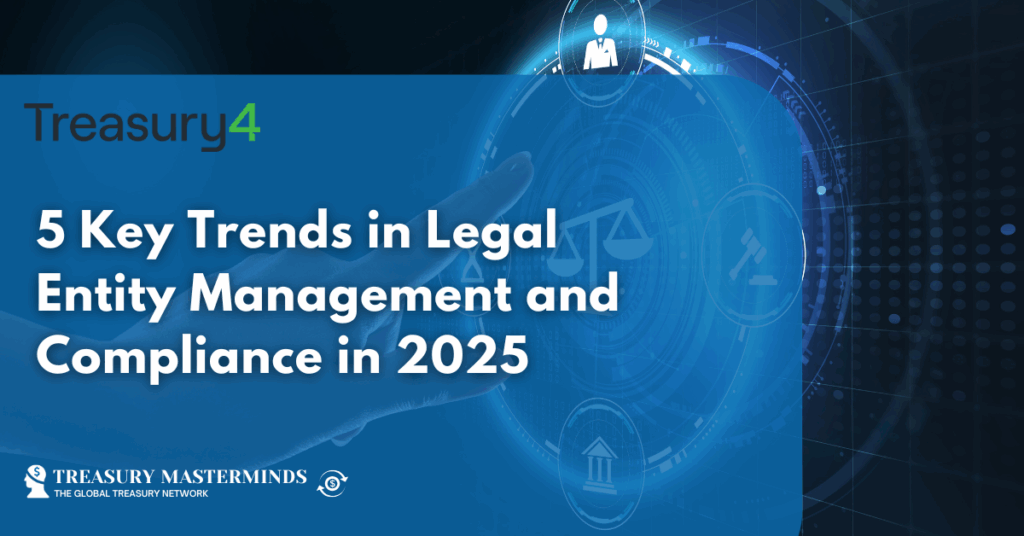
5 Key Trends in Legal Entity Management and Compliance in 2025
This article is written by Treasury4 In 2025, several new trends are taking shape in the world of legal entity management and compliance—and treasurers must be prepared to adapt. Driven by digital transformation, changing regulations, and an evolving global business environment, legal entity management and compliance have never been more complex—or more critical. Staying ahead of these developing trends is crucial for maintaining agility, operational efficiency, and regulatory compliance. By anticipating these changes, you can help your organization avoid costly missteps and capitalize on opportunities to enhance operations. In this article, we’ll explore the top trends developing in legal entity management and compliance in 2025. Trend 1: Digital Transformation in Entity Management The digital revolution is reshaping how organizations manage their legal entities in several ways. A multinational corporation managing hundreds of global subsidiaries could previously spend weeks preparing for audits. Modern entity management technologies, like those mentioned above, simplify this process by allowing for greater accuracy and agility. Trend 2: Growing Regulatory Complexity and Globalization While globalization has opened new markets for businesses, it also means that those organizations must navigate constantly evolving, jurisdiction-specific laws and regulatory requirements. From tax regulations to sustainability and ESG requirements to data protection laws, staying compliant across multiple jurisdictions requires constant vigilance. For instance, the General Data Protection Regulation (GDPR) in Europe and the California Consumer Privacy Act (CCPA) in the United States have set high standards for data privacy within their specific regions. Meanwhile, local nuances in corporate governance, such as reporting formats or filing deadlines, can vary widely by jurisdiction. To address these challenges, centralized legal entity management platforms have become more critical than ever. Centralized systems ensure stakeholders can track regional requirements from one location and that all records are up to date, reducing the risk of non-compliance. Another emerging trend is closer collaboration between businesses and regulators. Organizations are leveraging technology to provide real-time updates to regulators, fostering greater transparency and trust. Centralized legal entity management platforms are also beneficial for tapping into and sharing data. Trend 3: Enhanced Data Security and Privacy In an era where more organizations than ever are experiencing data breaches, ensuring the security and privacy of sensitive entity data is paramount. New data protection regulations are on the horizon in various jurisdictions, making it imperative for organizations to stay ahead of compliance requirements. For example, stricter penalties for non-compliance with privacy laws are expected, emphasizing the need for proactive measures. Legal entity management platforms can help companies stay compliant with data security regulations and protect critical information. For instance, role-based access features ensure that only authorized personnel can view or edit sensitive information. This prevents unauthorized access, limiting the potential for breaches. It also allows employees to access role-specific tools so they can continue to do their jobs without sacrificing data security. Advanced systems also provide audit trail functionalities, which record every action taken within the platform. This feature is invaluable during regulatory audits, as it allows organizations to demonstrate compliance and trace any irregularities back to their source. Trend 4: Advanced Reporting and Compliance Monitoring Comprehensive reporting capabilities are poised to be a game-changer in legal entity management this year. As businesses grow and expand across borders, maintaining transparency has become more important than ever for stakeholders and investors. Advanced reporting tools are helping enhance this transparency. Dashboards and visual data representations offer a bird’s-eye view of compliance metrics. These tools allow stakeholders to monitor the status of filings, renewals, and other critical tasks in real time, enabling prompt, data-driven action when needed. For instance, a dashboard might highlight discrepancies between legal entity structures and bank account setups, helping teams address issues before they escalate. Organizations are also using advanced reporting tools to strengthen governance frameworks. By analyzing historical data, businesses can identify patterns and implement preventative measures to mitigate future risks. Trend 5: Talent and Expertise Challenges The legal and compliance sectors face a growing skills gap. As regulations become more intricate, the demand for professionals who can navigate these complexities is outpacing supply. We’re seeing several trends emerge in how organizations are addressing this need: Looking Ahead: The Future of Legal Entity Compliance The above trends indicate a clear trajectory toward more efficient, transparent, and secure legal entity management practices. As organizations embrace these changes, we’re seeing treasury teams embrace several key strategies: Legal entity management and compliance are at a crossroads in 2025. From digital transformation and regulatory complexity to data security and talent shortages, the trends shaping this field reflect the dynamic nature of global business operations. As we move forward, the message is clear: Organizations that embrace innovation and leverage advanced tools will lead the way in building resilient, compliant, and future-ready enterprises. Also Read Join our Treasury Community Treasury Masterminds is a community of professionals working in treasury management or those interested in learning more about various topics related to treasury management, including cash management, foreign exchange management, and payments. To register and connect with Treasury professionals, click [HERE] or fill out the form below. Notice: JavaScript is required for this content.

The 3 D’s: How to Get the Best From Your Cash Forecast
This article is written by Palm We talk so much about cash forecasting and it’s importance, however how we approach this critical task has barely changed in the last 10 years. We may have added more data and reference points to help the analysis, but fundamentally we are looking at what has happened, adding in some general ledger data, the FP&A forecast and hoping for the best. The treasurer may go a step further and add their own view of the business progression to give an extra flavour. But the real science behind the numbers is rarely understood or utilised. …And we wonder why we some months we are so accurate, and others we are so wildly inaccurate it’s comical. In this blog we explore how to approach the task of cash forecasting differently. How to use the latest technology to break through into the new era of looking-ahead. The Opportunity: Where we can add real value by using the latest tools? 1. Data The data we use in our forecasts doesn’t have to be purely financial data relating to your internal operations. Think outside of the box about other external factors that effect the success of the business. Is it the weather forecast, the performance of the economy or the marketing of competitor products? Whatever it is, you can use this data to improve the quality of your cash flow forecast. 2. Details Imagine you had unlimited time to analyse every piece of data you feed into your forecast, for example, you could build in logic to understand the payment behaviour of each of your customers knowing some always pay between 3-5 days late depending one which day the invoice falls due and when their weekly payment run is. Or, a model that understands that before year end, some invoices due for payment are brought forward to limit open balance sheet positions. However, instead of spending hours analysing and creating this logic, the model understands these trends and does it for you. 3. Direction Unlike your best Treasury Analyst, your machine learning forecast model will never leave you. Therefore spending time teaching it all that you know, speaking to it directly to explain why somethings are correct and others aren’t, is a time investment that will pay off in dividends over the years. You can tell your forecast, for example, that it has misunderstood the seasonality of your business due to strange one-off behaviour and to exclude this from the its trend analysis in future. Giving this feedback regularly will also help the model learn more about the business and the trends it detects. The Technology: What do we need to achieve this? Although not new, it is surprising how few treasuries are using AI and machine learning in their day to day operations. According to the 2024 Deloitte survey, it is less than 2%. Is this because the technology is not properly understood? Or it’s application hasn’t been facilitated in a way that is accessible to treasurers? My suspicion is that it is a mix of both. What are the technologies you can use to realise the benefits we’ve outlined in the above sections? Predictive AI Using different data sets, AI can predict what will happen with the future of your cash flows. The difference between this technology and your treasury team itself, is that you can supply many different and varying data sets in different formats to feed the model. This will have a limited impact on the amount of time the forecast takes to produce however will significantly improve the accuracy. The difference between predictive AI and generative AI is that predictive AI uses existing data sets to predict what will happen in the future and is therefore most relevant for producing you cash flow forecast. Generative AI however creates new and original content, such as the commentary to support the forecast and understand the cash flows. Machine Learning Mathematical models are the foundation of machine learning, often using several at once and testing each of them until you find a blend that works. These can be refined over time to achieve the optimal solution. The Reality- What will happen when you bring these technologies into your treasury? When applying these systems and models you will be required a change your expectations of your forecast model. The advantage of using mathematical statistical models to produce your cash forecast means it will predict your cash flow for you, however you must relinquish your power to the model. You need to accept that you will not be able to click into a cell in excel and see how a number is calculated. You will not be able to “follow it through”. As many of the trends of patterns it detects are not necessarily explainable. Of course you can adjust the forecast and amend it to include the additional information you have, you could also feed it with a set of assumptions you believe to be true as guidance for the model to follow, for example, headcount is set to grow by 2% each month from now until the end of 2025 however on the most part you will not be able to see its inner workings. To become comfortable with this will take time and adjustment, building trust in the model over time and conducting regular variance analysis to pinpoint the route cause of any differences will help both you and the model. However, it is in embracing these innovations and new ways of looking at data that we can truly unlock our cash and bring efficiencies into our treasury teams. Also Read Join our Treasury Community Treasury Masterminds is a community of professionals working in treasury management or those interested in learning more about various topics related to treasury management, including cash management, foreign exchange management, and payments. To register and connect with Treasury professionals, click [HERE] or fill out the form below. Notice: JavaScript is required for this content.